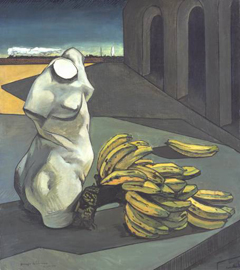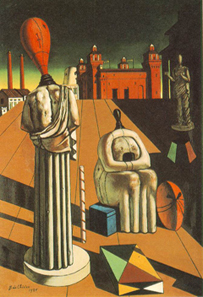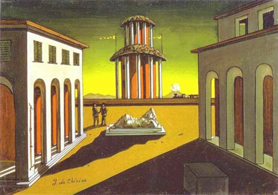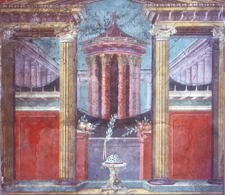Throughout De Chirico's lifetime the wall motif appeared and reappeared in literally hundreds of his paintings,sometimes hardly visible as in the Uncertainty of the Poet, 1913 (figs.1). Conversely, in paintings such as The Sarcophagus Date it is given an explicit dimension (fig.2). The wall, as a physical barrier between a seen and an unseen world, is also represented by many other more subtle manifestations. In a work such as The Disquieting Muses 1917 (fig.3) the extremely foreshortened ground plan becomes a substitute for the wall. The perspective of this flattened surface, perhaps a table top, gives the appearance of a plane almost perpendicular to our angle of vision. The top of this foreshortened surface terminates at a level where a similar wall motif might have ceased. Somewhat ambiguously, the orthogonals on the ground plan contradict the natural horizon of the buildings that rise up from behind them. This creates the effect of two distinct planes, similar to the way in which the wall is used to denote shallow and deep space in many of his paintings.
In A Concise History of Modern Painting published in 1959, Herbert Read included this quote by De Chirico on the subject of the wall, “Sometimes the horizon is defined by a wall behind which rises the noise of a disappearing train. The whole nostalgia of the infinite is revealed to us behind the geometrical precision of the piazza. We experience the most unforgettable moments when certain aspects of the world whose existence we completely ignore, suddenly confront us with the revelation of mysteries lying all the time within our reach and which we cannot see because we are too short-sighted and cannot feel because our senses are inadequately developed. Their dead voices speak to us from nearby, but they sound like voices from another planet.” The wall motif in De Chirico’s painting and in tragic-style wall-painting represents both the symbol and the context for the drama. It is like the Chorus in Greek Tragedy, which Schiller described as a “living wall”, both informing and separating the audience from the dramatic tragedy. The primary signifier that allows the tragic drama to unfold beyond the wall is the tholos, the circular colonnaded shrine that is depicted in numerous De Chirico easel paintings and tragic-style wall-paintings (figs.4-5).
 1
1 3
3 4
4 5
5